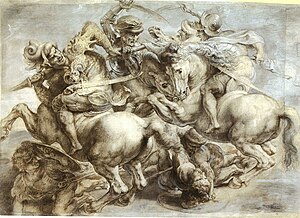
The Battle of Anghiari (1505) is a painting by Leonardo da Vinci in the Salone dei Cinquecento (Hall of the Five Hundred) in the Palazzo Vecchio, Florence. Its central scene would have depicted four men riding raging war horses engaged in a struggle for possession of a standard at the Battle of Anghiari in 1440.
Many preparatory studies by Leonardo still exist. The composition of the central section is best known through a drawing which was made in the 16th century and later acquired by Peter Paul Rubens who extended the edges of the drawing. The drawing is in the collection of the Louvre in Paris, where it is referred to as The Battle of the Standard.[1] This drawing succeeds in portraying the fury, the intense emotions and the sense of power that were presumably present in the original painting. Similarities have been noted between this Battle of Anghiari and the Hippopotamus Hunt painted by Rubens in 1616.
In March 2012, a team led by Maurizio Seracini announced that they had found evidence that the painting still exists on a hidden inner wall behind a cavity, underneath a section of Giorgio Vasari's fresco in the chamber.[2] The search was discontinued in September 2012, without any further progress having been made, due to conflict among the involved parties.[3]
In 2020, a group of art historians submitted the findings of their research on the work. Their conclusion was that the work had never been commenced or executed because Leonardo could not have created the painting as his proposed gesso and oil technique for making the layer for the painting would not have allowed the paint to attach to the wall.[4]
- ^ 'La lutte pour l'étendard' de la 'Bataille d'Anghiari'/ at the Louvre
- ^ Kington, Tom (12 March 2012). "Art historians say they have found evidence of hidden Leonardo da Vinci". The Guardian. London. Archived from the original on 15 December 2016. Retrieved 13 December 2016.
- ^ Lorenzi, Rosella (22 September 2012). "Search for Mysterious Lost Da Vinci Aborted". Discovery News. London. Archived from the original on 3 July 2013. Retrieved 22 March 2013.
- ^ Greenberger, Alex (13 October 2020). "Leonardo's 'Lost Masterpiece' Can't Be Found Because It Was Never Painted, Experts Claim". ARTnews. Archived from the original on 10 December 2021. Retrieved 9 May 2022.